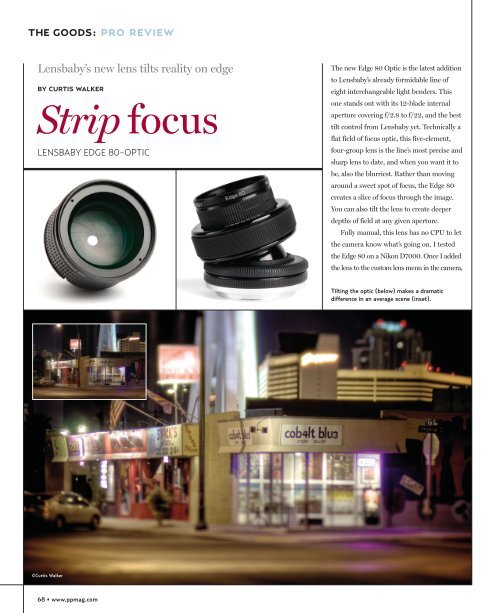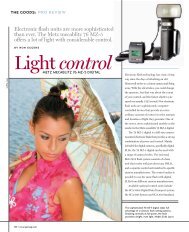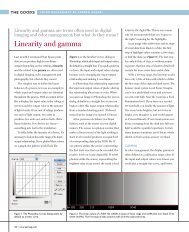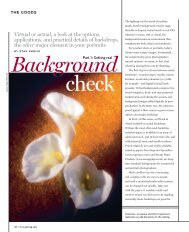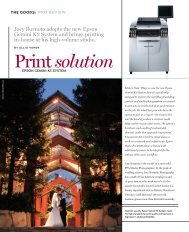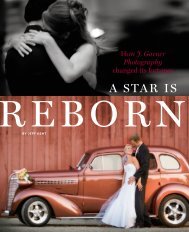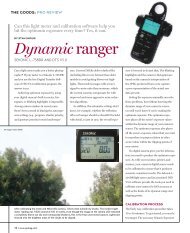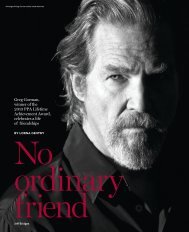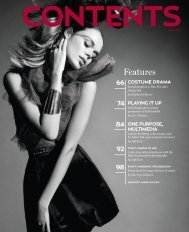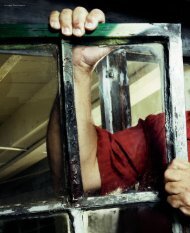Lensbaby Edge 80-Optic - Professional Photographer Magazine
Lensbaby Edge 80-Optic - Professional Photographer Magazine
Lensbaby Edge 80-Optic - Professional Photographer Magazine
You also want an ePaper? Increase the reach of your titles
YUMPU automatically turns print PDFs into web optimized ePapers that Google loves.
THE GOODS: PRO REVIEW<br />
<strong>Lensbaby</strong>’s new lens tilts reality on edge<br />
BY CURTIS WALKER<br />
Strip focus<br />
LENSBABY EDGE <strong>80</strong>-OPTIC<br />
The new <strong>Edge</strong> <strong>80</strong> <strong>Optic</strong> is the latest addition<br />
to <strong>Lensbaby</strong>’s already formidable line of<br />
eight interchangeable light benders. This<br />
one stands out with its 12-blade internal<br />
aperture covering f/2.8 to f/22, and the best<br />
tilt control from <strong>Lensbaby</strong> yet. Technically a<br />
flat field of focus optic, this five-element,<br />
four-group lens is the line’s most precise and<br />
sharp lens to date, and when you want it to<br />
be, also the blurriest. Rather than moving<br />
around a sweet spot of focus, the <strong>Edge</strong> <strong>80</strong><br />
creates a slice of focus through the image.<br />
You can also tilt the lens to create deeper<br />
depths of field at any given aperture.<br />
Fully manual, this lens has no CPU to let<br />
the camera know what’s going on. I tested<br />
the <strong>Edge</strong> <strong>80</strong> on a Nikon D7000. Once I added<br />
the lens to the custom lens menu in the camera,<br />
Tilting the optic (below) makes a dramatic<br />
difference in an average scene (inset).<br />
©Curtis Walker<br />
68 • www.ppmag.com
©Curtis Walker<br />
Without the tilt employed, the <strong>Edge</strong> <strong>80</strong> optic will deliver a silky bokeh and won't distort your subject.<br />
TTL metering worked fine but, of course, not metal chassis is also compact, and can live<br />
stop-down metering. The ease of changing on the front of a camera body without risk.<br />
the internal aperture is a welcome change If you already have or prefer the Composer,<br />
from the orig inal magnetic disc system, afford - Scout, Muse or Control Freak lens bodies,<br />
ing far greater ease in composing optimal this optic will swap right into place.<br />
depth of field.<br />
Learning to use the <strong>Edge</strong> <strong>80</strong> takes a bit<br />
At <strong>80</strong>mm, this lens is best suited for use of practice. The focus is controlled in a<br />
with a full-frame camera. On the other hand, straight line of depth of field anywhere in<br />
putting it on my Nikon F3 breathes new life the image. It can be horizontal, slanted or<br />
into the old body, and the lens benefits from vertical, depending on how you tilt the optic,<br />
the bright viewfinder and split-prism focus although it’s not a tilt/shift lens, as there’s no<br />
screen. On the D7000, the crop factor of 1.5 way to shift the image circle of the lens<br />
gives the lens an effective focal length of 120mm. around on the sensor or film.<br />
That’s a bit long for my tastes, but perfectly In tight spaces, the shallow depth of field<br />
usable when I moved back a few steps. The lens can completely obliterate background texture.<br />
has a minimum focus distance of 17 inches, In large spaces, the depth of field can be forced<br />
fully adjusted. It has 46mm threads out front, to create a particular perspective and a minia -<br />
so there’s no hope of a quick fix from <strong>Lensbaby</strong>’s turization of reality. The lens performs mar -<br />
37mm wide-angle or telephoto accessories. velously when left untilted as well, creating<br />
Pair it with the Composer Pro lens body, silky bokeh as lush as a Gaussian filter.<br />
and the combo offers a durable, dust-free, Shooting with this lens opens the pho -<br />
ball-joint-based way to experiment. The tographic perspective in a satisfying way. In<br />
that aspect, anyone who can afford to get<br />
one and learn to use it will see an improve -<br />
ment in his craft and get a low-impact crash<br />
course in the Scheimpflug Principle. Wedding<br />
and portrait photographers have long been<br />
fans of Lensbabies, and this one is impressive.<br />
This optic is likely to attract a slew of new<br />
users as well, due to its robust construction,<br />
ease of use and, well, loveliness. In terms of<br />
fun, the <strong>Lensbaby</strong> system is nearly unparalleled.<br />
Hiking to the top of the nearest parking<br />
garage and capturing something remi -<br />
niscent of Olivo Barbieri’s work is creatively<br />
invigorating, to say the least.<br />
It’s a challenging optic to master, but with<br />
some practice this versatile lens can create<br />
images that will set your work apart in a way<br />
that post processing can’t. It literally forces the<br />
photographer to focus on what’s impor tant.<br />
For anyone who has been waiting for <strong>Lensbaby</strong><br />
to build a truly beautiful lens, this is it. The<br />
<strong>Lensbaby</strong> <strong>Edge</strong> <strong>80</strong> <strong>Optic</strong> sells for $300. n<br />
©Curtis Walker<br />
The depth of field can be forced to create an<br />
engaging toy-like perspective of miniaturization.<br />
March 2012 • <strong>Professional</strong> <strong>Photographer</strong> • 69


